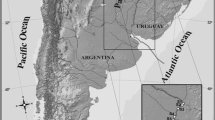Abstract
The identification of an indicator for monitoring pesticides is a very effective analytical approach because it allows one to schedule and simplify the analytical routine. In this study, a new indicator has been designed, which has to be able to define a scale of priorities in the pesticides monitoring. A starting equation was developed involving the escaping tendency of a given substance from a phase (based on the Mackay model I level). The reliability of the indicator was tested by application to a model system, consisting of a defined and limited area, choosing water as matrix over a period of 6 years. A group of marker compounds was also defined to implement the predictive efficacy of the indicator. The results obtained by modeling were compared to those obtained by experimentation of the same model system. The indicator was subsequently and appropriately modified creating a new equation, including a kinetic factor, which considers the environmental degradation processes. The effect of the rectified indicator was consistent with the sales data list of compounds, when applied to the markers. The indicator developed in this study, tested as a model on specific area-phase-period (Province of Siena, water phase, 2000–2006), is applicable to any other area-phase-period, adjusting the partition value of the Mackay model for the case under study.
Similar content being viewed by others
References
Bacci, E. (1992). Ecotoxicology of organic contaminants. London: Lewis.
Borroni, M. (2007). WIN-BDF BANCA DATI FITOFARMACI computer package, service pack 4 for Microsoft Windows NT, Prod. Ecospi s.r.l. Milano, Distrib. Ed. “L’informatore Agrario”, Verona.
Businelli, M. (1991). Il controllo degli inquinamenti in agricoltura; gli inquinanti organici. In Chimica del suolo. P.Sequi coord. Bologna: Patron.
CHEMFINDER (2000). Scientific Database Gateway. http://www.chemfinder.camsoft.com.
Chiou, C. T., Schmedding, D. W., & Manes, M. (1982). Partitioning of organic compound in octanol-water systems. Environmental Science & Technology, 16, 4–10.
CPCN (2009). Compendium-Of-Pesticide-Common-Names. http://www.alanwood.net/pesticides.
CRPV (2009). Centro Ricerche Produzioni Vegetali—Archivio, Fitofarmaci. http://www.net-agree.com/fitofarmaci/.
EPA (2005). USA Environmental Protection Agency. Document: EPA/600/R-05/053 Method 535. Measurement of chloroacetanilide and other acetamide herbicide degradates in drinking water by solid phase extraction and liquid chromatography/tandem mass spectrometry (LC/MS/MS), version 1.1, April 2005, J.A. Shoemaker, M.V. Bassett.
ExToxNet (1998). EXTENSION TOXYCOLOGY NETWORK. http://www.extoxnet.orst.edu.
FAO (2007). Pesticide Management. http://www.fao.org/ag/AGP/AGPP/Pesticid/Events/PMUpdate1.pdf.
FITOGEST (2009). Il motore di ricerca dei fitosanitari. http://www.fitogest.com.
Mackay, D. (1979). Finding fugacity feasible. Environmental Science and Technology, 13(10), 1218–1223.
Mackay, D. (1982). Fugacity revisited. Environmental Science & Technology, 16, 654A–660A.
Mackay, D., & Paterson, S. (1981). Calculating fugacity. Environmental Science & Technology, 15, 1006–1014.
Miller, G. T., Jr. (1994). Living in the environment: Principles, connections, and solutions. Belmont: Wadsworth.
OSU (2009). OSU-EXTENSION-PESTICIDE-DATABASE. http://npic.orst.edu/ppdmove.htm.
PAN (2009). PAN Pesticides Database. http://www.pesticideinfo.org/Index.html.
REACH (2006). (Registration, Evaluation Authorisation and Restriction of Chemical substances) Official Journal of the European Union. Parliament and council regulation (ec) no. 1907/2006 (corrigendum 29 may 2007) and directive 2006/121/ec (Corrigendum 29 May 2007), http://eur-lex.europa.eu/LexUriServ/LexUriServ.do?uri = oj:l:2006:396:0001:0849:en:pdf.
Sicbaldi, F., Sarra, A., & Copeta, G. L. (1997). Diatomaceous earth-assisted extraction for the multiresidue determination of pesticides. Journal of Chromatography A, 765, 23–30.
Tomlin, C. (1994). The pesticid manual. UK: Crop Protection.
Author information
Authors and Affiliations
Corresponding author
Rights and permissions
About this article
Cite this article
Luchi, F., Vigni, V., Basosi, R. et al. A novel environmental indicator for monitoring of pesticides. Environ Monit Assess 177, 151–163 (2011). https://doi.org/10.1007/s10661-010-1626-x
Received:
Accepted:
Published:
Issue Date:
DOI: https://doi.org/10.1007/s10661-010-1626-x




